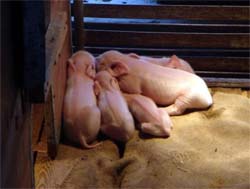
One of the long-standing headaches for hog husbandry is the high mortality of weaning piglets. As the result of four years of arduous study, a group of CAS scientists have made progress in solving the problem.
Headed by Prof. YIN Yulong with the CAS Institute of Sub-tropic Agriculture in Changsha City, capital of south China's Hunan Province, the team has developed a new fodder featuring high nutrients and free of antibiotics and hormone residues.
Pork is the staple meat in China. In a hog-raising farm, the weaning piglet always poses a challenge to hog breeders because up to 60% of the weaning piglets will suffer from diarrhea, making the morality rate to 15-20%. To address the problem, farmers often resort to antibiotics as a constant additive to the fodder, which will not only result in the poorer immunity of the animals, but also pose threat to food safety and people's health.
With the support of the Ministry of Science and Technology, the CAS headquarters and the Hunan Provincial S&T Bureau, the research group, teaming up with local co-workers, conducted a project on the influence of functional amino acids and plant abstracts on a piglet's nutritional physiology as well as their application.
As a result, the team revealed a molecular-level mechanism through which the amino acids promote the piglet's sound growth and detected the circulation pattern of protein in the piglet's body when the latter was fed with low-protein fodder but reinforced by additional additives of amino acids. The team's exploration led to the discovery of a structural affinity between biogastrone acid and the hormone glucocorticoid and development of a new herbal drug to regulate the nutritional composition concurrently having the alimentary functions of the hormone and antibiotics.
Based on the rewarding research findings, a special fodder was developed for feeding weaning piglets and distributed to hog farms in Hunan, Fujian, Guangdong, Shanghai and other hog-producing provinces and municipalities. The results are: the diarrhea incidence sees a landslide 90% drop while their survival rate goes up from 90% to 97% and the daily weight-increasing rate up to somewhere between 5% and 8%. On the other hand, the fodder cost is reduced by 15-20 yuan per ton. At the same, due to the lowered response to the weaning effect occurring in the piglet's body, incidence rates of intestine disorders and respiratory diseases are cut down dramatically, leading to a drastic decrease in the clinical dosage of antibiotics.







